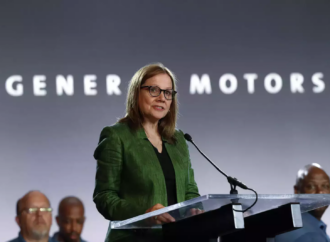Leaders need to be proactive and diligent about checking in with employees on their satisfaction with their career prospects and their mental health.
Candid conversations with employees about their professional interests and career goals and take action to support those interests. Many employees are leaving their current roles to learn new skills in a different industry. It’s worth the investment to offer skills development programs or coordinate a transfer to a new internal role to retain a valued employee. Leaders also need to be proactive and diligent about checking in with employees on their satisfaction with their career prospects and their mental health.
The pandemic has allowed people to reevaluate what they want from work. This “Great Reevaluation” has led to the “Great Resignation” which has left the US with a great big labour shortage and a supply chain crisis.
What can we do to reverse this trend? What can be done to attract great talent to companies looking to hire? What must companies do to retain their great talent? If not just a paycheck, what else are employees looking for? In this interview series called “The Labor Shortage & The 5 Things We Must Do To Attract & Retain Great Talent” we are talking to successful business leaders who can share stories and ideas from their experiences that can address these questions.
As a part of this interview series, we had the pleasure to interview Dr. Mary-Clare Race. Dr. Mary-Clare Race the Chief Innovation and Product Officer at LHH, with responsible for the quality of the LHH solution.
Mary-Clare and her team of designers, psychologists, consultants, and creatives are passionate about helping individuals and organizations get more out of their career journeys and are constantly looking for new and innovative ways to solve client challenges.
Mary-Clare has over 15 years of experience in human capital consulting, including career transition, leadership & management development, coaching, diversity & inclusion, and organizational design.
She has extensive experience working with clients in the financial services, pharmaceuticals, consumer goods, luxury brands, and government sectors. Mary-Clare earned a PhD in Philosophy from University College London, an MSc in Occupational Psychology from The University of Sheffield, and a BSc in Social Psychology from Ulster University.
Thank you so much for joining us in this interview series! Our readers would like to get an idea of who you are and where you came from. Can you tell us a bit about your background? Where do you come from? What are the life experiences that most shaped your current self?
I am the Group Head of Product and Innovation at LHH, where I lead a team focused on finding new and innovative ways of helping people succeed in their careers and helping organizations achieve success through their people. I am an Organizational Psychologist with a PhD in Psychology, a Masters’s in Organizational Psychology, and a Bachelor’s degree in Social Psychology my career has been dedicated to using psychology to design solutions that help people flourish at work.
I am passionate about this topic because I believe that for far too many people work is something to be endured and something that drains their energy rather than being the thing that energizes them and gives them a greater level of purpose — and yet we know it doesn’t have to be like this and we have the tools to change it for them — but we’re not always great at putting these tools in their hands in the right way.
My interest in psychology and human behaviour developed at a young age — my parents were foster carers and over a ten-year period, we had almost 20 kids come and live with us for a period of time. I credit this experience with helping develop the deep interest I have in how people behave and why they do what they do.
Right now I live in Dublin, Ireland, and I have lived and worked in almost every corner of the world — in the U.S., in various parts of Europe, in the Middle East, and in Australia. Whilst there are undoubtedly differences in how different cultures think and behave when it comes to working, I also believe there are some universal truths about people that we can learn from.
Let’s jump right in. Some experts have warned of the “Great Resignation” as early as the 1980s and yet so many companies seem to have been completely unprepared when it finally happened. What do you think caused this disconnect? Why do you think the business world was caught by surprise?
I think for a while now there has been a “hustle culture” that has been building in the workplace where people and organizations have viewed putting in long hours as almost a badge of honour. People got hooked on busyness and all the trappings that often sit alongside a busy work life — business travel, after-work social time with colleagues and clients, expensive coffees on the way to the office, and workout classes during lunch breaks. People were in many cases already overworked and feeling the stress of all of this effort, and then when the pandemic came along, it stripped everything away and the act of working and the reality of our jobs was laid bare. And a lot of people realized this wasn’t what they wanted.
It brought everything into stark reality and many employees began realizing just how burned out and unhappy their job was making them. Working from home gave many employees the perspective that there was another way to work, where they could balance their personal and professional lives in a healthier way. While in the early months of the pandemic, many employees were focused on job security and were thankful just to have a job even if they weren’t satisfied, but when the economy turned around, things shifted pretty quickly. At LHH, we call it the “Great Re-Evaluation” in which employees are rethinking their priorities, both personal and professional, and starting to evaluate whether their current role supports those priorities.
Meanwhile, businesses were focused on getting through the economic challenges of the pandemic and in many cases, survival. In those early days, investment in people and helping their workforce through the “Great Re-Evaluation” just wasn’t on their radar. And so companies likely didn’t see this coming for two reasons: one, they were laser-focused on business continuity and two, because of the fact that many employees were working remotely and they didn’t have the same level of face time with their employees, they didn’t have a handle on how big of a toll mental wellness challenges and burnout were taking on their workforce.
What do you think employers have to do to adapt to this new reality?
First, I think that employers need to understand that the workplace has fundamentally changed, and they have to be willing and ready to change with it. This will require a completely different mindset. For example, companies will have to stop thinking about roles and start about thinking skills, stop looking at past experience as the main indicator of future performance and start talking about goals and passions, stop thinking of work as a 9-to-5 endeavour, and get more flexible based on employee wants and needs. Organizations will have to get more creative in how they think about attracting talent and how they engage their employees. They will need to prioritize employees’ health and wellness and their need for flexibility.
Based on your opinion and experience, what do you think were the main pain points that caused the great resignation? Why is so much of the workforce unhappy?
There are a few distinct reasons in my opinion and a lot of this goes back to the “hustle culture” that I mentioned earlier where many employees were already suffering from burnout and wanting a different way to work and live.
But there are some practical reasons too. People now feel confident changing jobs — many held off during 2020 and the first half of 2021 because of uncertainty in the market. Confidence has now returned
and there are more jobs to move to. Companies also held off on hiring during this period but hiring activity has now dramatically increased so it stands to reason that people will now move to take these jobs.
Many people are also now more financially secure due to savings accrued during the periods of lockdown so they are more willing to take a risk and make the career decision that is right for them.
The great resignation is also symptomatic of a greater paradigm shift and this goes back to the point I made earlier. People don’t want to go back to the office in the way they were working before — there is a demand for a hybrid approach that works for all, and we know from our “Resetting Normal: Defining the New Era of Work” study that this is NOT A NICE-TO-HAVE, but an expectation from workers going forward.
This paradigm shift has also led to a greater demand for learning and skill development:
People have had time and space to reflect on their career choices and recognized that life is too short to do a job they don’t love. And they’re ready to hit play again on their careers — learning and development were put on pause, especially in the work context. We’ve already talked about how most organizations were focused on adjusting and adapting and just trying to stay afloat, so training their employees was not necessarily top of the agenda. Now, many people have begun to question the relevance of their skillset, and they may feel the only option is to move jobs to continue to grow.
Finally, a big driver has been the well-being pandemic that has occurred alongside the Covid-19 pandemic. I’ve referenced before that this was already in motion as a result of the pandemic and the results of it are clear to see. According to LHH and the Adecco Group’s “Resetting Normal” research, two-thirds of U.S. workers reported working more than 40 hours a week over the past year. Meanwhile, more than half of young leaders (54%) reported suffering from burnout and three in 10 said their mental and physical health has declined in the last 12 months.
People have begun to see there is a different way and that we can achieve the lifestyle we’ve always wanted whilst still being able to pursue our careers — companies who don’t offer this flexibility are likely to see resignations.
The key to moving forward is listening to employees and having a pulse on what they want, which today is a lot more flexible in how they work. Thankfully, many companies are catching on to this and adjusting their policies. For instance, in a recent survey from LHH Recruitment Solutions, 48% of HR decision-makers indicated that their organization is allowing more remote hires.
Many employers extoll the advantages of the entrepreneurial spirit and the possibilities of an expanded “gig economy”. But this does come with the cost of a lack of loyalty among gig workers. Is there a way to balance this? Can an employer look for single-use sources of services and expect long-term loyalty? Is there a way to hire a freelancer and expect dependability and loyalty? Can you please explain what you mean?
As with full-time and salaried employees, contract workers and freelancers are dependable and loyal if they are compensated competitively, treated with respect, and made to feel they are part of a positive culture. Hiring temporary or contract employees can be a valuable investment, particularly to fill skill and staffing gaps created during the Great Re-Evaluation. In my opinion, an organization should put the same effort into engaging a ‘gig worker’ with their organization and treating them with respect and dignity as they do their full-time resources — for too long we have treated these two workforces as separate entities when it comes to engagement and motivation.
It has been said that “people don’t quit jobs, they quit bosses”. How do you think this has been true during the Great Resignation? Can you explain what you mean?
Managers play a huge role in employee satisfaction. LHH Recruitment Solutions’ survey found that 55% of HR decision-makers believe that a strong leadership team makes talent want to work at their organization. In the early months of the pandemic, when fear and uncertainty were at a peak, employees expected their leaders to offer empathy and psychological safety. However, some leaders with strong technical skills were lacking in soft skills like emotional intelligence. Focusing on fostering a strong, positive workplace culture is more important than ever and managers who exhibit emotional intelligence and commitment to meeting the needs of and supporting their teams will be best positioned to retain talent.
One often-overlooked factor is that a lot of managers themselves are struggling with burnout right now, and it’s difficult to make some of the cultural shifts that need to be made to attract and retain talent when leaders are burned out. It’s important to tackle the whole organization with wellness efforts — including leaders and all levels of employees — to retain great talent.
Finally, I would say that the Covid-19 pandemic shone a light on the true state of leadership in our organizations. The sad reality is that going into 2020 many of our leaders were not exhibiting the behaviours they needed to and this became more pronounced during Covid-19 when those so-called softer skills were critical. What we have seen as a result is people making decisions to seek out roles in other organizations where they feel they will be managed by a more effective, empathic, emotionally intelligent leader who knows how to help them navigate the challenges of today.
I am fond of saying, “If it’s fun they charge admission. But you get a paycheck for working here.” Obviously, I am being facetious, but not entirely. Every job has its frustrations and there will be times when every job will aggravate employees. How important is it that employees enjoy their jobs?
Fulfilment might be a better word to use than enjoyment here. I think employees today are looking for inclusion, flexibility, and more ownership over their careers and lives. They are looking for autonomy and personalization versus a one-size-fits-all approach to how they learn and progress. It’s human nature that we seek out situations that challenge us to grow and master new skills in a way where we feel connected to a purpose. We are never going to enjoy every minute of our jobs, but I think if those things are in place, people feel fulfilled and this will lead to enjoyment. How important is it? I would say it’s critical. In 1976 Mihály Csíkszentmihályi coined the concept of “flow” to explain the state in which people are so involved and energized by their work that nothing else seems to matter. His body of research showed that happiness is not a fixed state but can be developed as we learn to achieve flow in our lives — and when we achieve this, the positive impacts for both the individual and the organization are profound.
How do you think an unhappy workforce will impact a) company productivity b) company profitability c) and employee health and wellbeing?
When employees are engaged in their work and satisfied in their roles, they are more productive, which then supports company profitability. Data from Oxford University found that happy workers are 13% more productive. That’s why investing in employee wellness and satisfaction has never been more critical of a priority.
One benefit that can address both employee well-being and productivity is offering flexible working arrangements. As burnout intensifies and interest grows in a four-day work week, employees are calling for their performance to be measured, not by their hours, but on results: 73% of global workers polled by LHH and the Adecco Group shared they would prefer their performance be measured by outcomes rather than hours. Similarly, HR leaders polled by LHH Recruitment Solutions reported that the two most important benefits to hiring a remote workforce include more satisfied employees (ranked by 20% of respondents as most important) and a more productive workforce (ranked by 18% of respondents as most important).
What are a few things that employers, managers, and executives can do to ensure that workers enjoy their jobs?
Have candid conversations with employees about their professional interests and career goals and take action to support those interests. Many employees are leaving their current roles to learn new skills in a different industry. It’s worth the investment to offer skills development programs or coordinate a transfer to a new internal role to retain a valued employee. Leaders also need to be proactive and diligent about checking in with employees on their satisfaction with their career prospects and their mental health.
Can you share a few things that employers, managers, and executives should be doing to improve their company’s work culture?
What doesn’t work when it comes to culture is a “gimmicks” approach or the idea that offering new and more perks, such as free yoga, will lead to real cultural change. Culture has to be authentic and it really comes down to an organization’s mission and values and how they put those into action. That’s what will attract and keep employees.
Organizations should also prioritize wellness, and that doesn’t mean exercise breaks once a week but rather a much more holistic approach to ensuring that employees’ mental health needs are being met and that they have the flexibility to work in ways that make sense for them. Leaders, coach and develop them to have not only the skills needed for the specifics of their roles but also the soft skills like emotional intelligence, communication and empathy that will foster a healthy culture where people can make their best contribution.
Leaders should also be prioritizing diversity in the hiring process as a way to improve their company’s culture. One way to do this is through allowing more remote hires — 48% of LHH Recruitment Solutions’ survey takers reported that their company is doing so in order to diversify their candidate pool. Equally important is building a culture of inclusion where this diverse talent is appreciated and recognized for their value — leaders need to take responsibility for creating an environment where all contributions are welcomed and every voice can be heard.
Finally, organizations need to tackle toxic leadership behaviour when it arises. In fact, LHH’s new Readiness Index revealed that 41.6% of respondents feel their workplace is toxic. The prevalence of this in organizations continues to be high and few organizations have made serious attempts at addressing this type of ruinous behaviour.
Okay, wonderful. Here is the main question of our interview. What are your “5 things employers should do to attract and retain top talent during the labour shortage?” (Please share a story or example for each.)
- Don’t forget about salary–While benefits and positive company culture are important, competitive compensation is still a key tactic to attract and retain talent. Especially in light of rising inflation, existing employees and prospective candidates recognize their worth and are expecting to be compensated competitively in exchange for their loyalty. Stay up to date on salary ranges by industry and proactively make competitive offers to new talent or adjustments to base pay for existing talent.
- Offer flexibility and remote options–After maintaining productivity after years of remote work, many employees are simply not willing to go back to a traditional in-office 9 to 5 working experience. A lack of flexibility and remote options is a deal-breaker for many candidates. Not only this, hiring for remote roles can also help widen the pool of available talent for a role and help smaller companies in particular compete with larger companies that may have more resources at their disposal.
- Streamline the interview process — The hiring process is moving at lightning speed. In some industries, like engineering and logistics, job offers are being made in a matter of days or even hours. Recruiters are following up with talent multiple times a day to stay up to date on their availability. Companies can’t afford to lose time during the interview process. In fact, 59% of LHH Recruitment Solutions’ survey respondents say their organization has shortened its interview and offer process to meet current demand and competition.
- Offer bonuses and enticing benefits — Sign-on bonuses, merit bonuses, and even retention bonuses can be a compelling benefit for prospective and existing talent. Forty per cent (40%) of hiring managers surveyed by LHH Recruitment Solutions reported increasing their sign-on bonuses in an effort to attract top talent. Similarly, offering attractive benefits like 401ks, unlimited PTO, and robust health care plans are still very compelling to talent. These extra offerings can make the difference between two competing offers.
- Invest in employee growth — Don’t neglect to promote internally to fill the role. Training an existing employee to take on a new challenge can be very rewarding as they already have an understanding of the company and its culture. LHH Recruitment Solutions’ survey found that 54% of hiring decision-makers are upskilling current employees in order to fill the increased need for specific workplace skills.
We are very blessed that some of the biggest names in Business, VC funding, Sports, and Entertainment read this column. Is there a person in the world, or in the US with whom you would love to have a private breakfast or lunch, and why? He or she might just see this if we tag them.
I have long been an admirer of Satya Nadella — the CEO of Microsoft — who in my opinion had led one of the most successful examples of culture change in modern times. I would love to hang out with him and ask him exactly how he did it and hear what advice he has for organizations who perhaps know they are not getting it right but don’t know where to start when it comes to changing their culture.
























Leave a Comment
Your email address will not be published. Required fields are marked with *